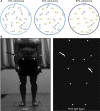Do different experimental tasks affect psychophysical measurements of motion perception in autism-spectrum disorder? An analysis
- PMID: 30588145
- PMCID: PMC6296182
- DOI: 10.2147/OPTO.S179336
Do different experimental tasks affect psychophysical measurements of motion perception in autism-spectrum disorder? An analysis
Abstract
There is a rapid increase in the number of individuals with high-functioning autism (HFA). Research on motion perception in HFA has shown deficits in processing motion information at the higher visual cortical areas (V5/middle temporal). Several hypotheses have been put forth to explain these deficits as being due to enhanced processing of small details at the expense of the global picture or as a global integration abnormality. However, there is a lot of variability in the results obtained from experiments designed to study motion in adults with autism. These could be due to the inherent diagnostic differences within even the same range of the autism spectrum and/or due to comparison of different experimental paradigms whose processing by the same visual neural areas could be different. In this review, we discuss the various results on motion processing in HFA, as well as the theories of motion perception in autism.
Keywords: autism-spectrum disorder; biological motion; form perception; global motion; high-functioning autism; local motion; motion perception; random-dot kinematogram.
Conflict of interest statement
Disclosure The authors report no conflicts of interest in this work.
Figures




Similar articles
-
Magnocellular visual evoked potential delay with high autism spectrum quotient yields a neural mechanism for altered perception.Brain. 2010 Jul;133(Pt 7):2089-97. doi: 10.1093/brain/awq122. Epub 2010 May 30. Brain. 2010. PMID: 20513659 Clinical Trial.
-
Global Motion Perception in Autism Spectrum Disorder: A Meta-Analysis.J Autism Dev Disord. 2019 Dec;49(12):4901-4918. doi: 10.1007/s10803-019-04194-8. J Autism Dev Disord. 2019. PMID: 31489542 Free PMC article.
-
Self-motion perception in autism is compromised by visual noise but integrated optimally across multiple senses.Proc Natl Acad Sci U S A. 2015 May 19;112(20):6461-6. doi: 10.1073/pnas.1506582112. Epub 2015 May 4. Proc Natl Acad Sci U S A. 2015. PMID: 25941373 Free PMC article.
-
Vagaries of visual perception in autism.Neuron. 2005 Nov 3;48(3):497-507. doi: 10.1016/j.neuron.2005.10.018. Neuron. 2005. PMID: 16269366 Review.
-
Disrupted action perception in autism: behavioral evidence, neuroendophenotypes, and diagnostic utility.Dev Cogn Neurosci. 2012 Jan;2(1):25-35. doi: 10.1016/j.dcn.2011.05.005. Epub 2011 May 27. Dev Cogn Neurosci. 2012. PMID: 22682727 Free PMC article. Review.
Cited by
-
Segregated Dynamical Networks for Biological Motion Perception in the Mu and Beta Range Underlie Social Deficits in Autism.Diagnostics (Basel). 2024 Feb 13;14(4):408. doi: 10.3390/diagnostics14040408. Diagnostics (Basel). 2024. PMID: 38396447 Free PMC article.
References
-
- Time C, Methodoloa SD, Lotter A, Wing N, Ishii NR, Bohman NR. [Accessed November 22, 2018];Summary of Autism Spectrum Disorder (ASD) Prevalence Studies. 2015 1986 Available from: www.cdc.gov/ncbddd/autism/data.html.
-
- Frith U. Autism: Explaining the Enigma. 2nd ed. Malden, MA: Wiley Blackwell; 2003.
-
- McPartland J, Klin A, Volkmar F. Asperger Syndrome Assessing and Treating High Functioning Autism Spectrum Disorders. 2nd ed. New York: The Guilford Press; 2014.
-
- Bakroon A, Lakshminarayanan V. Visual function in autism spectrum disorders: a critical review. Clin Exp Optom. 2016;99(4):297–308. - PubMed
Publication types
LinkOut - more resources
Full Text Sources

